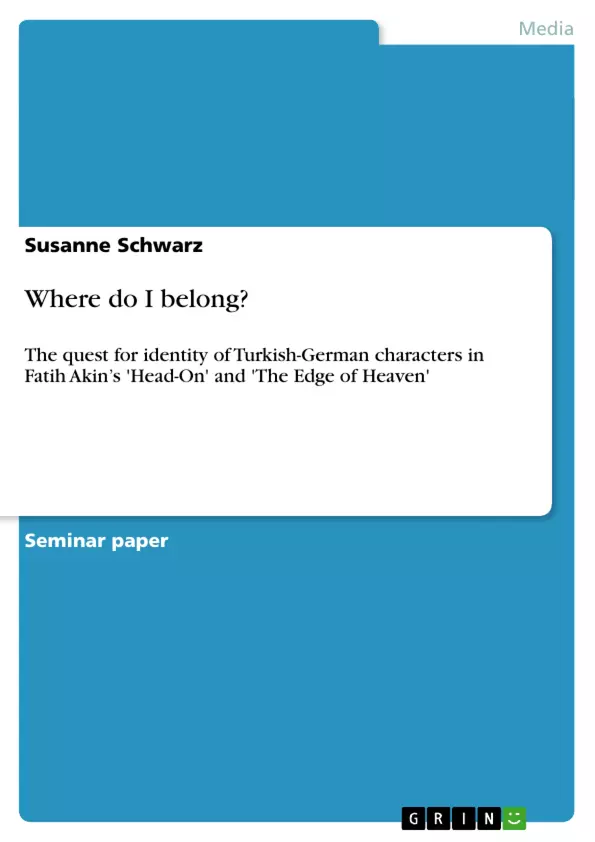In the 1980s Turkish-German cinema started to become an important impact on German national cinema. But sine the 1980s much has change in the cinematic representation of Turks, living in Germany. The former ‘mute Turk’ (Bhabha, 1990, pp. 315 - 317), the guest worker that was excluded from German society has become the multicultural second-generation immigrant that owns a German passport. Turkish-German filmmakers such as Fatih Akin, Thomas Aslan or Yüksel Yavuz deal with the topic of Turkish-German identity (Göktürk, 2002, pp. 253 – 255). Unfortunately, academics have not yet caught up with contemporary cinema: most critics still talk about the representation of immigrants as victims in western society. In Crossing The Bridge, Akin seems to celebrate Istanbul’s diversity and one wonders if contradictions can exist next to each other. Cultural extremes cause tensions. And these tensions are displayed in the Turkish-German characters of Akin’s feature films. To represent the being in-between Turkish and German culture of his characters, Akin uses the image of crossing between extremes. He crosscuts between two countries, Germany and Turkey. In Head-On (2004) the female character Sibel crosses between genders: she is a woman but acts like a man; she wears man’s clothes and behaves aggressively. The characters cross between languages: the Turkish-German protagonists speak both, Turkish and German, at the same time. Sometimes, they even switch into the other language within one sentence. This essay will analyse how Fatih Akin represents the character’s being in-between two cultures in his film Head-on and The Edge of Heaven (2007). At first, there will be a short part about Fatih Akin, then, I will give a short overview of both films, the issues and the characters. Finally, there will be an analysis of several sequences about the topics: countries, languages and gender.
Inhaltsverzeichnis (Table of Contents)
- Introduction
- Fatih Akin and the Turkish-German Identity
- Films
- Crossing the countries
- Crossing the languages
- Crossing the genders
Zielsetzung und Themenschwerpunkte (Objectives and Key Themes)
This essay aims to analyze how Fatih Akin represents the characters' being in-between two cultures in his films Head-on and The Edge of Heaven. It will explore how Akin uses the image of crossing extremes to portray the Turkish-German identity through the themes of countries, languages, and gender.- The portrayal of Turkish-German identity in Fatih Akin's films
- The use of crossing extremes to represent the being in-between two cultures
- Analysis of countries, languages, and gender as symbolic representations of cultural boundaries
- The role of music and imagery in establishing cultural atmospheres
- The impact of Turkish-German cinema on German national cinema
Zusammenfassung der Kapitel (Chapter Summaries)
- Introduction: This chapter sets the context for the essay by discussing the evolution of Turkish-German cinema, the portrayal of Turks in German society, and the concept of "crossing the bridge" as a metaphor for Turkish identity.
- Fatih Akin and the Turkish-German Identity: This section introduces Fatih Akin, a second-generation Turkish-German filmmaker, and discusses his personal experiences that shaped his perspective on identity. It highlights his status as an "accented filmmaker" and the emphasis on identity in his works.
- Films: This chapter provides an overview of Head-On and The Edge of Heaven, two films that focus on the complexities of Turkish-German identity. It emphasizes the films' use of cultural elements like music, language, food, and clothing to highlight the themes of cultural intersectionality.
- Crossing the countries: This section examines how Akin utilizes contrasting representations of Turkey and Germany in his films. It analyzes the use of traditional Turkish music, imagery, and shooting styles to create distinct cultural atmospheres and highlight the tension between the two countries.
- Crossing the languages: This chapter will explore the role of language in portraying the Turkish-German identity. It will analyze how the characters' use of both Turkish and German reflects their bicultural background and the constant negotiation between the two languages.
- Crossing the genders: This section will discuss the representation of gender in the films, focusing on the character Sibel in Head-On. It will analyze how Sibel's non-conformity to traditional gender roles reflects her own struggle with identity and the complexities of being in-between genders.
Schlüsselwörter (Keywords)
This essay explores the complexities of Turkish-German identity in the context of Fatih Akin's films. It examines the themes of cultural crossing, biculturalism, and the use of language, gender, and imagery to represent the struggle of belonging to two distinct cultures. Keywords include Turkish-German identity, Fatih Akin, Head-On, The Edge of Heaven, cultural crossing, biculturalism, language, gender, music, and imagery.- Quote paper
- Susanne Schwarz (Author), 2009, Where do I belong?, Munich, GRIN Verlag, https://www.grin.com/document/136792



